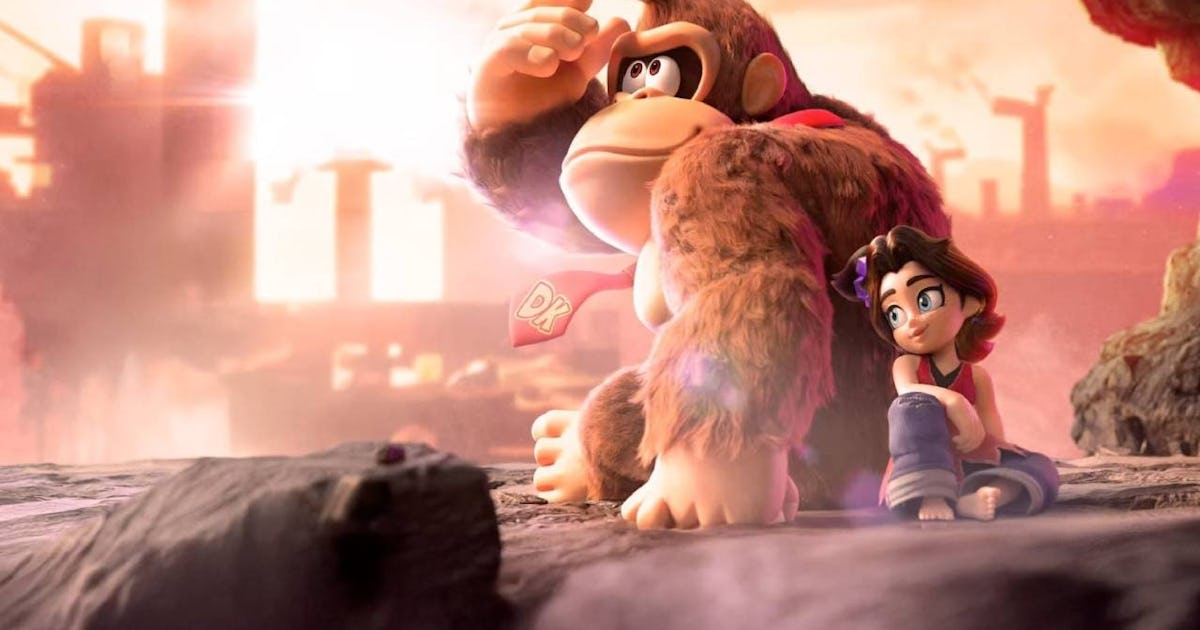One moment in Donkey Kong Bananza felt like a revelation – like seeing the image of the Mona Lisa for the first time. I’d simply punched my way straight down a mountain and landed on a Banandium Gem. Sprawled behind me was a lengthy platforming puzzle. My wanton destruction had let me punch my way out of doing an entire puzzle, and now the possibilities seemed endless.
Donkey Kong Bananza gives Mario’s rival ape the biggest adventure he’s had since the Nintendo 64, and it’s hard to think of a better killer app for the Nintendo Switch 2 right now. But even more than that, Bananza feels like one of the most innovative games that Nintendo has put out in decades – adding it to the already lengthy list. It’s a fantastically freeing platformer that gives you the tools to shape and mold the environment how you see fit, and complements it with wild powers, smart puzzles, and fantastic boss battles. A Nintendo platformer hasn’t felt this revolutionary since Super Mario Sunshine – and even though I’ve done everything in the game, I can’t stop playing.
Dynamic Duo
Bananza is filled with little details, like the way DK practically starts salivating when he’s near Banandium.
Nintendo
Bananza kicks off on Ingot Isle. The Kong’s irrepressible obsession with bananas is stronger than ever, mining for the rare but decidedly delicious-looking Banandium Gems. But his expedition is cut short when a scrungly little ape named Void Kong shows up with his company VoidCo and a giant digger, tunneling into the ground — which sends DK and all the apes on Ingot Isle plummeting into the underground.
While getting his bearings, and through a series of events, DK meets the young girl Pauline (who you may remember from Super Mario Odyssey) and the two head out on a journey that will create a remarkable friendship.
The single best word I can think of to describe Bananza is joyful. It’s a game that’s simply a joy to play in nearly every way, and impossible not to have a smile plastered over your face the entire time. And that applies, more broadly, to both the mechanical experience of playing the game and the story.
DK and Pauline travel through various “layers” of the underground world, all in the hopes of reaching the planet’s core and finding the Banandium Gem, which is said to grant wishes. DK, of course, wants an endless supply of bananas, while Pauline simply longs for her home on the surface. And while Bananza’s destructive gameplay is the star of the show, I think a special mention needs to be given to the game’s story, which I found vastly more engaging than your typical 3D Mario entry.
A trio of new Kongs join the party in Bananza.
Nintendo
Nintendo games are no strangers to sidekicks, like Odyssey’s Cappy, but Pauline is far away the best in any of these games. And that’s largely because of how closely she’s integrated into the game’s mechanics, and because of the heartwarming friendship at the game’s core. This is truly a story about the importance of friends and how collaboration lets us soar to heights we could have never dreamed of on our own. While other characters do make noises, in DK fashion, Pauline is the only “voiced” character in the game, and that feels intentional. She’s not just your guide through this world; she’s the world’s voice.
Her musical talents are a central part of the story, but more meaningful is how she constantly chats and interacts with DK. The two share excitement whenever you complete a layer, both smile wide whenever you collect Banandium, and have dozens of little interactions. My favorite part, however, are the Getaways that you can build across the map: little rooms with a bed to restore your health. Each time you sleep, you get a little conversation with Pauline, talking about everything from how delicious burgers are to why this world’s version of an ostrich can fly. These are delightful little talks that add so much color and personality to the relationship.
Monkeying Around
Bananza’s destruction is sublime, equally applying to enemies as well.
Nintendo
But as much as I love all those story elements, they’re masterfully woven into one of the most dynamic gameplay experiences I’ve seen in years. Destruction is at the heart of everything in Bananza, and I mean that quite literally.
The story does guide you along a route, but Bananza truly shines in the abundant freedom it gives you — how you approach finding collectibles, solving puzzles, and generally exploring massive worlds bristling with secrets.
The entire environment is made up of different terrain that DK can punch through, destroy, rip out of the earth, and more. You can punch in three different directions (up, down, forward) and have a host of different skills for messing with the world. Nearly everything in the game is destructible in some way, meaning you can literally punch through mountains, creating massive tunnel networks that, somehow, hold their shape in the world — even if you teleport to another layer and come back.
A few other abilities are layered on top of those core mechanics. DK can rip chunks out of the Earth and throw them, or use them to double jump with a “Chunk jump,” or he can surf over land and water on the chunk. You can also slap the ground to let out a sonar wave, highlighting any collectibles and points of interest in the immediate area. Layered on top of all this are the utterly fantastic Bananza transformations, letting DK morph into the likes of an Ostrich or Zebra — and gain unique new powers in the process. With the Ostrich you can fly and glide over distance, and the Zebra lets you dash over crumbling terrain, among other things. These Bananzas, combined with DK’s base abilities, let you interact with the world in dozens of dynamic ways.
Bananza consistently gives you new ways to use its ideas and elements, like the chunk surf.
Nintendo
I’ve never played a game with such satisfying destruction. (Even the likes of Red Faction: Guerrilla simply doesn’t come close.) The world can be molded in any way you want, making the possibilities staggering. You can literally approach exploration in any way you want. Every time I’d get to a new layer, I’d immediately ignore the story objective and spend a half dozen hours just smashing things around like a toddler in a sandbox.
But the hand-crafted Nintendo elements are here as well, in the form of levels and challenges you can find in the world. The structure of these is very much like how the campaigns in the Splatoon games work, an overworld with deliberately designed side levels that force you to use specific mechanics or ideas — and can often be surprisingly challenging. But crucially, these hand-designed levels always feel dynamic and exciting, sometimes referencing previous Donkey Kong games with minecart or barrel blasting segments. Other times, forcing you to use the game’s mechanics in completely unexpected ways, giving you new ideas to use in exploration.
Bananza also has one of the most incredibly intuitive map systems I’ve ever seen in a video game, seamlessly pulling a direct scan of the world that shows all of your destruction, and every single little detail you could want.
Feel the Beat
The Bananza transformations are one of the game’s biggest innovations, with impeccable levels designed around each.
Nintendo
Everything has a fantastically compelling loop in Bananza, every element of the game ties together in a vast web; story, exploration, levels, etc. A big part of this is because there’s a constant sense of reward for literally everything you do. Each layer is littered with dozens of fossils to find, which you can exchange at the shop for new costumes for both DK and Pauline. These costumes, in turn, can enhance your skills or discovery, like giving you a 30 percent extra chance to spawn a chest when you destroy terrain, which holds either gold or a map to a fossil. Similarly, every five Banandium Gems you collect grant you a skill point, which you can use to boost DK’s basic abilities and Bananza abilities. That means exploration is a key part of improving DK and allowing you to explore even better, and there’s seldom a moment where you feel like you aren’t doing something meaningful.
Furthering all of that is the fact that each and every layer feels both tonally and visually distinct. Bananza really leans into bright, whimsical colors that make each layer feel like an almost alien world. One is a poisonous swamp with a massive golden egg hotel at the center, another a cheerful beach getaway filled with giant square-shaped fruit (all of which you can eat). It’s another aspect where I find the most apt comparison is actually Splatoon, not Mario, because of how richly vibrant and colorful these worlds feel — backed up by an eclectic mix of pop and big band music.
Bananza has a host of outfits you can unlock, which lets you coordinate the fits for the duo in some extremely cute ways.
Nintendo
It’s genuinely difficult to point out any flaws in Bananza, outside of an occasionally unwieldy camera or some performance dips or more demanding boss battles. Some of the latter worlds do drag on a bit too long, but even then, it’s hard to call that much of a flaw, because towards the end, you’ve unlocked so many abilities that it’s just a blast to play around with different Bananza transformations.
While there are clear through lines between Bananza and games like Splatoon, collectathons like Banjo-Kazooie, and Mario Odyssey, what surprised me the most is how unlike anything else it feels. This is a game that feels revolutionary in so many ways, almost a Breath of the Wild equivalent for platformers. It just keeps taking me back to Super Mario Sunshine, and how wildly inventive that game’s water mechanics felt at the time. It’s the kind of game that even after 40 hours, after doing every single post-game challenge, I’m still craving more. I want to uncover every single collectible and see every inch this world has to offer.
Donkey Kong Bananza is a statement from Nintendo — making it clear that the company’s innovation isn’t going to stop on Switch 2. And it’s fair to say that this is a game that could have only been achieved on this new system, with how wildly ambitious its world structure and destruction are. Bananza isn’t just a system seller; it’s a genre-defining game that others will likely be looking to for years to come.
10/10
Donkey Kong Bananza launches on July 17, exclusively for Nintendo Switch 2.
INVERSE VIDEO GAME REVIEW ETHOS: Every Inverse video game review answers two questions: Is this game worth your time? Are you getting what you pay for? We have no tolerance for endless fetch quests, clunky mechanics, or bugs that dilute the experience. We care deeply about a game’s design, world-building, character arcs, and storytelling come together. Inverse will never punch down, but we aren’t afraid to punch up. We love magic and science-fiction in equal measure, and as much as we love experiencing rich stories and worlds through games, we won’t ignore the real-world context in which those games are made.
Source link
Video Games,Nintendo,nintendo,video-game-reviews,gaming,donkey-kong,homepage,hp-latest,adex-light-bid,switch-2




Average Rating